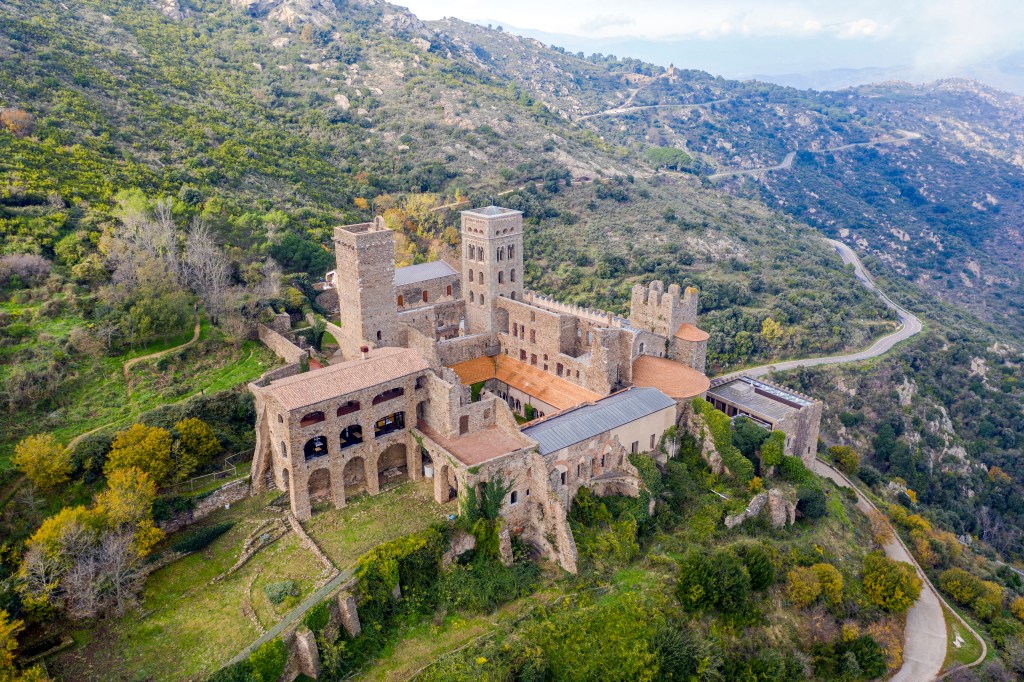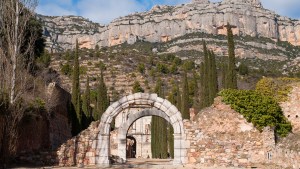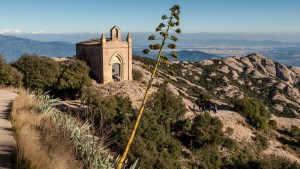The monastery of Sant Pere de Rodes (Catalan for St. Peter of Rodes) is a former Benedictine monastery in the province of Girona, northeast of Catalonia, Spain. Standing on the top of the rugged Serra de Rodes (hence its name), the monastery is quite literally what legends are made of.
The monastery was built in the 9th century just below the ancient Castle of Sant Verdera. Back then, the castle provided protection for the monastery. Nowadays, only some of its noble ruins can be found there, at the very summit of the Serra. There are records of another nearby monastery, Santa Creu de Rodes, that stood near a medieval town of the same name –of which its pre-Romanesque-style church dedicated to St. Helena is all that remains.
That is to say, only the monastery of St. Peter is still standing, as if its massive yet sober walls would echo the Benedictine monastic ethos of stability.

Strategically perched overlooking the Mediterranean Sea, the monastery was not only a religious retreat but also a formidable fortress, guarding against the relentless menaces of piracy, invasion, and pillage. But, on the inside, a serene cloister invited contemplation – in fact, it still does. Its unassuming elegance, far from commonplace, immediately compels visitors to reflect, meditate, and contemplate.
Yet, what truly sets St. Pere de Rodes apart is the legend surrounding its founding. Whereas the true origins of the monastery are not known (nor registered), local tradition claims that the remains of St. Peter (and other saints) were brought to this hilltop by Benedictine monks to save them from pillage, as invading hordes were occupying territories formerly owned by the Western Roman Empire in the early 7th century. Once the danger had passed, Pope Boniface IV (who was also a Benedictine) commanded them to build a monastery. They just kept the name of the saint whose remains they (allegedly) once guarded.
However, none of this is properly documented. The first written testimony of the existence of the monastery is from 878, when it was mentioned as a simple monastery cell consecrated to St. Peter. These kinds of single cenobitical cells are not unusual in the Catalonian hills – in fact, once Benedictine monks from the great abbey of Cluny arrived in the area, hermitages, chapels, and monasteries flourished in the region. It was not until 945 when a complete Benedictine monastery was founded, led by an abbot. It reached its maximum splendor between the 11th and 12th centuries, until its final decay in the 17th century. Its increasing importance is reflected in its status as a point of pilgrimage. In fact, it was once one of the main religious centers of the area, and people would go up the steep hills to visit the place that (again, allegedly) once protected the remains of the first pope.
The monastery was declared a national monument in 1930. In 1935 the first restoration work was initiated. Nowadays, visitors can spend the day in contemplative walks, circumambulating the cloister, as monks once did.



